I wanted to explore the best options for SaaS content management systems, including what a SaaS CMS is, the types of SaaS CMS, and, of course, the best CMS options for SaaS businesses.
Table of Contents
What Is a SaaS CMS?
A SaaS CMS is a Content Management System designed to support SaaS businesses. Like all good CMS platforms, a SaaS CMS will offer the same as a traditional CMS. You’d expect to manage content, create pages, log activity and changes to your site, and more.
A CMS specifically for SaaS will ideally have CMS features that support the SaaS business. For example, you might want a CMS that integrates with your product’s users so you can manage user accounts, including sign-ups, billing, account management, trials, renewals, and more.
SaaS CMS Types
Before we get into the five best SaaS content management systems, let’s define types of CMS and who they’re best for.
Coupled CMS
A coupled CMS is a content management system in which the data stored in the back end and the data displayed on the front end are directly linked.
Most people are familiar with a traditional coupled CMS; providers such as WordPress, Squarespace, and Wix have made it popular. WordPress is a traditional CMS, and it powers 43.4% of all websites — pretty impressive!
The coupled elements of a traditional CMS are commonly referred to as the front end (the website, or the content, as the user sees it) and the back end (content storage, media libraries, content fields, WYSIWYG editors, etc.).
The primary focus of this type of CMS is to make building a product (in many cases, a website) accessible to anyone, as it has no barrier to entry.
The coupled CMS is typically presented as a templated interface where the user fills in the blanks, and a styled and functional product is returned.
The advantage of this type of system is that the product can usually be built very quickly and can be built by anyone, regardless of skill level.
The disadvantages of this type of system is that they are usually very rigid, with limited customization options. The stored data is baked into the output and therefore cannot be used in any other way.
Examples of coupled CMS include Content Hub, WordPress, Squarespace, and Wix.
Best for: Start-ups who can mold the business somewhat to the functionality available and smaller companies with standard content management needs. I need to be careful because a traditional CMS is also suitable for larger businesses and open source options (like WordPress) are pretty limitless!
Decoupled CMS
Unlike a coupled CMS, a decoupled CMS separates the content management back end from the front end.
It is similar to coupled but with a more integrated approach between the back end and front end, allowing for easier content delivery while maintaining flexibility.
In a decoupled system the CMS is used to define and store data, unlike a coupled system where the CMS is used to design and build layouts or visual elements.
The advantage of this system is that data is separate from the front end. Making significant changes to the product such as a rebrand is much easier because the CMS data is independent of the front-end output.
The disadvantage of this system, compared to coupled, is that it requires expertise from software developers and designers to build the front end. However, this does allow for much more customization.
Examples of decoupled CMS include Drupal, WordPress.
Headless CMS
In the traditional sense, a CMS typically has a “body” and a “head.” The body refers to the content and the content manager, and the head refers to the front end, i.e., what the user sees.
As the name might suggest, a headless CMS does not include the front end part. A headless CMS is used to define and store data, which can then be queried by external systems. Those external systems then decide how to present that data.
The headless option, compared to traditional, offers more flexibility in delivering content to various platforms.
A headless CMS depends on an API. Editors add content to the CMS, and external publishing tools use APIs to access the content.
Ahrefs uses a great pizza analogy to show how content (or ingredients) is pieced together to deliver different types of content. It’s an approachable example of how content can be served in diverse formats.
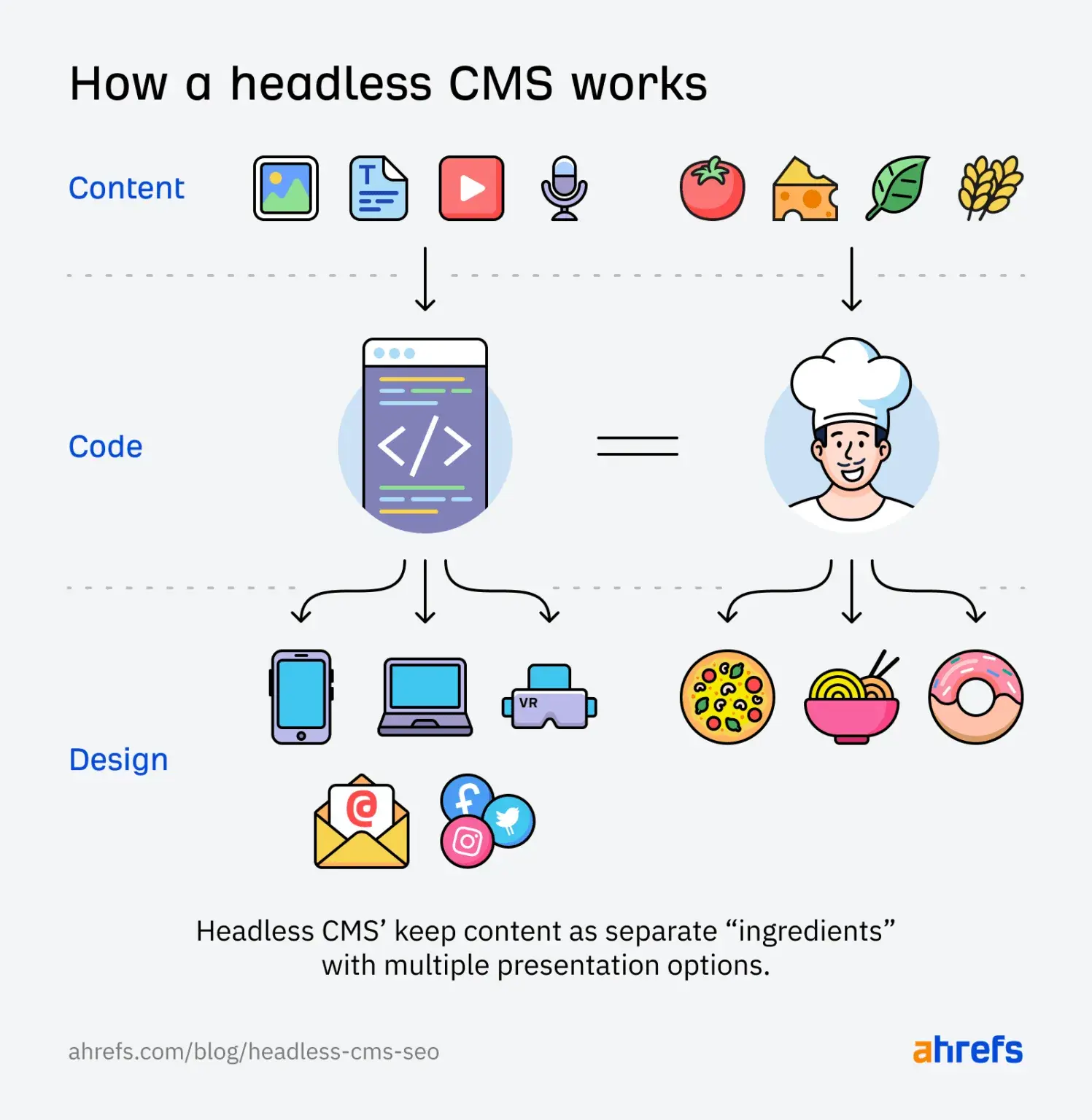
Examples of headless CMS include Strapi, Contentful, and ButterCMS.
Best for: Businesses with a large content delivery network.
Best SaaS CMS Options
I wanted to gather the best SaaS CMS options, so I reached out to people working for SaaS companies. I asked them which CMS they were using and what made it the best CMS for SaaS.
Content Hub
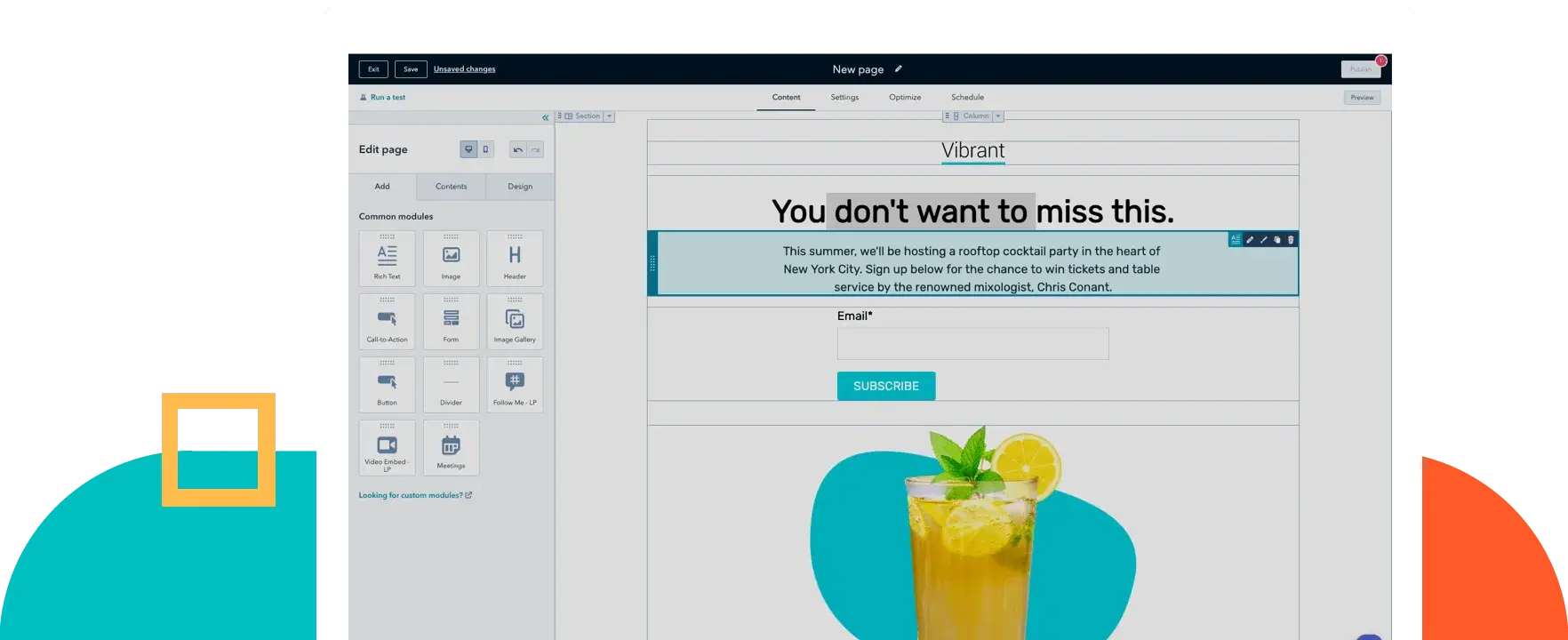
HubSpot is one of the top SaaS companies with its own CMS, Content Hub. Considering HubSpot developed the CMS, you can bet that it was centered on SaaS businesses.
Content Hub is an AI-powered CMS designed to help businesses manage content with ease. At the click of a button, you can use AI to generate ideas, images, web pages, content, and so much more.
The drag-and-drop editor makes it easy for anyone to build pages, and if you’re using HubSpot’s CRM, the CMS will integrate seamlessly, too.
Features
- Unbeatable AI features that will make your marketing and content generation effortless.
- Drag-and-drop editor.
- Website analytics included.
- Build on your own domain.
Pro tip: The AI features can be used for so many tasks. You can build pages, generate images, and write entire articles. Don’t sleep on HubSpot’s AI; the faster you integrate it into your processes, the better you become at using it, and the more time you save.
Pricing: You can use Content Hub for free.
Best for: Beginners and start-ups as well as larger companies.
WordPress
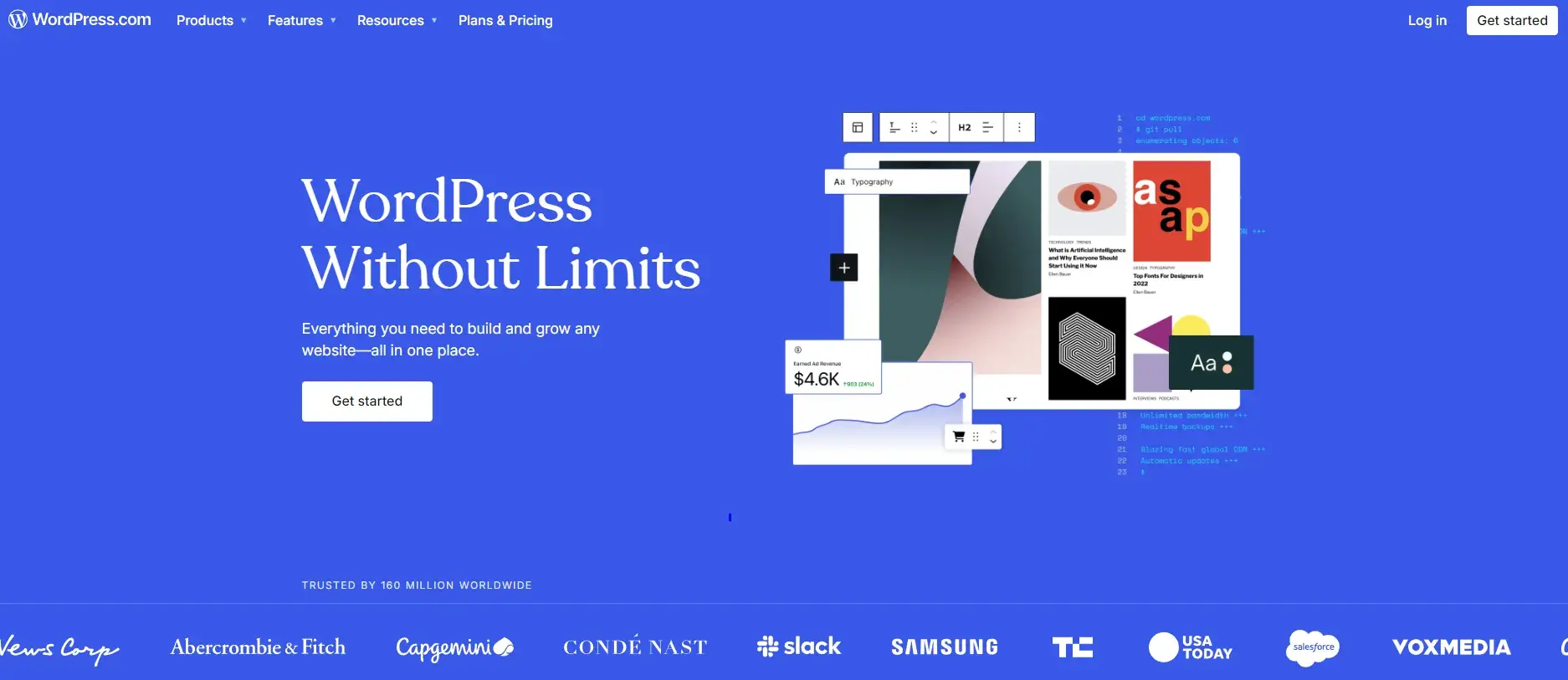
When I contacted SaaS experts, I received many recommendations for WordPress. It’s no surprise, considering the stat stated above, that WordPress powers 43.4% of websites.
I’ve worked with many content management systems and have always loved WordPress. In my experience, it gets a hard time because it can be vulnerable without updates and correct management, but if you look after it, WordPress is safe and secure.
Because WordPress is open source, many developers have created plugins that will solve almost any problem you can think of. This means you can build your perfect solution using a range of plugins, many of which are free.
Marci Pegg, Global Chief Marketing Officer at Inspera, uses WordPress. One of Pegg’s considerations when choosing the best CMS for SaaS was a CMS with the functionality to integrate with HubSpot.
Pegg says, “WordPress does this seamlessly. We want to track metrics such as churn rate and customer lifetime value (CLV). Plus, we want to expand into using lead scoring and adding our website engagement into renewal management. All of this is data where website metrics can help. Without a CMS that‘s able to integrate effectively, we wouldn’t be able to make it happen.”
Using WordPress with HubSpot, Pegg says they were able to “leverage the strengths of both platforms. WordPress, with its flexibility, open-source nature, and extensive ecosystem of plugins, allows us to create a highly customizable and scalable website.”
Meanwhile, HubSpot’s powerful marketing automation, CRM, and lead management capabilities enhance their customer engagement, streamline lead capture, and nurture workflows directly from their site. This integration ensures they deliver personalized content and experiences to their visitors while optimizing their marketing efforts through detailed analytics and automation, Pegg explained to me.
“This combination provides us with the best of both worlds: the creative freedom and control of WordPress alongside the comprehensive marketing and CRM tools of HubSpot, enabling us to grow our business effectively while maintaining flexibility and scalability.”
Pro tip: Before you build any complex functionality, try the plugin library first. So many problems have been solved with modular plugins on WordPress.
Features
- Extensive library of website templates.
- Extensive library of free and paid plugins that are rated by the community.
- Open-source, so you’re not limited by the platform.
Pricing: WordPress can be used for free, but packages start at as little as $4.
Best for: Businesses without development teams, small businesses to enterprises.
Storyblok
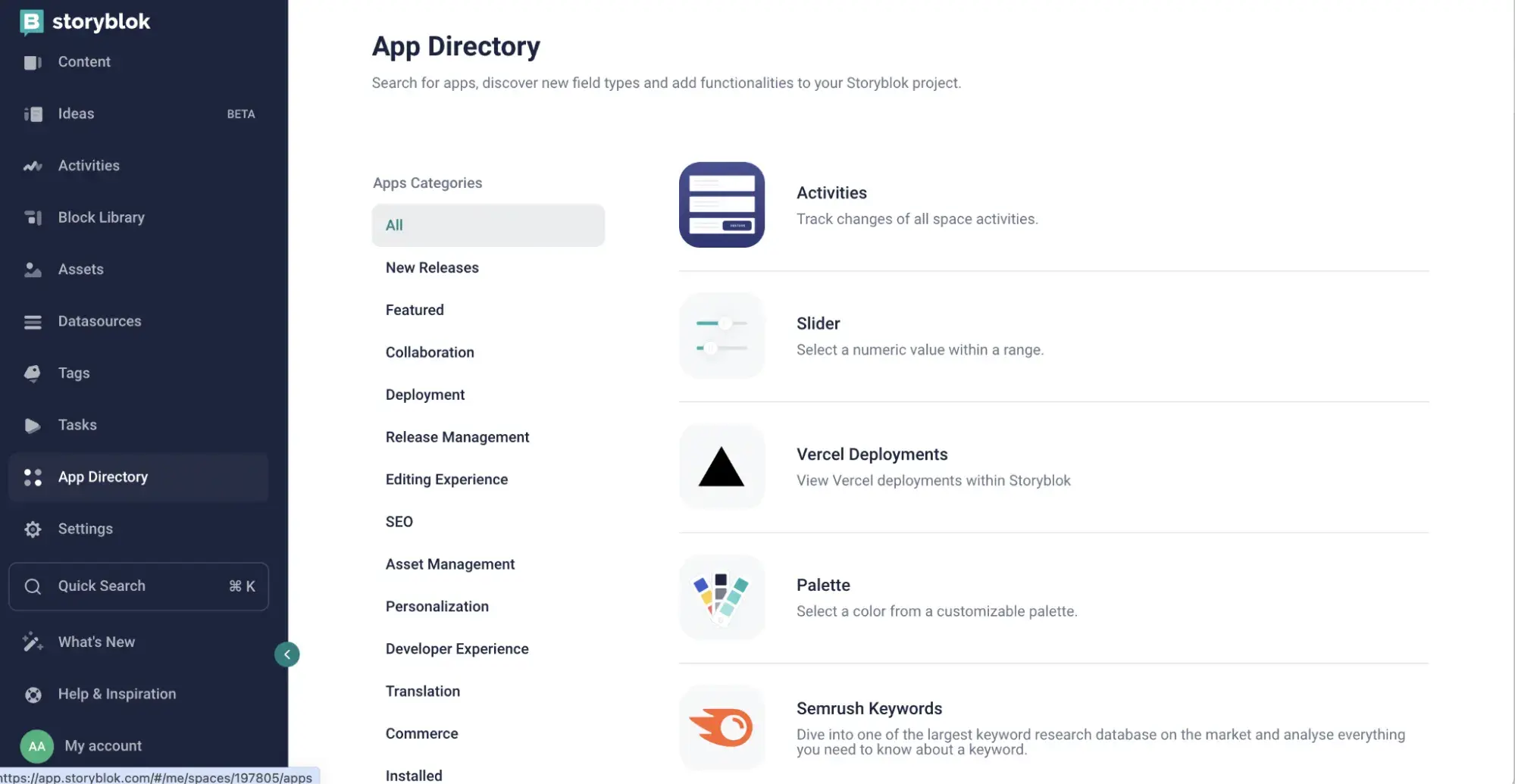
Storyblok is a headless content management system. It offers developers and content creators the flexibility they need to build and manage content-rich experiences.
With Storyblok, you can use the editor to edit and preview content in real time, without needing technical knowledge.
Storyblok was recommended as the best CMS for SaaS by Adì Aviram, Content and SEO Manager at Linearity.
Aviram says, “Things in SaaS change fast. With new features being developed at speed we needed a CMS that can keep up.
“Storyblok allows us to stay agile and change content at scale easily. With easy drag-and-drop for content editors, it caters to our non-tech staff. The devs love it because it’s a headless CMS and integrates easily with our wider tech stack. A feature I’ve personally been impressed with is the app directory. I can pick and choose useful plugins by myself without developer help.”
Pro tip: Like WordPress, you can solve many problems with the Storyblok apps. Use the app directory before you engage developer support to see if there’s an existing solution.
Features
- Intuitive visual editor.
- App directory.
Pricing: You can start with Storyblok for free, or choose a package.
Best for: Teams managing complex content strategies and/or businesses looking for a future-proof CMS that provides creative control and technical flexibility.
Statamic CMS
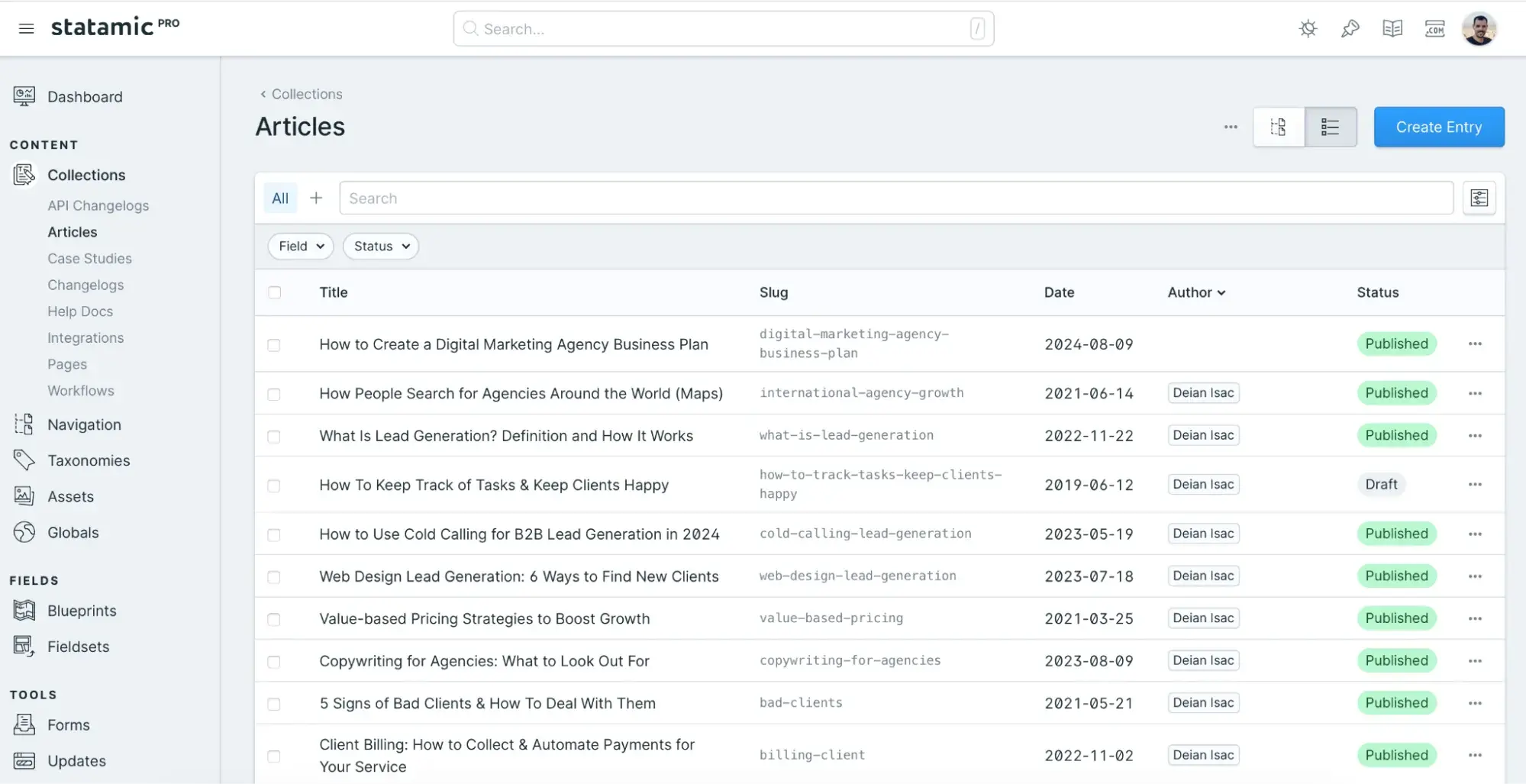
Deian Isac, Head of Agency Success at Service Provider Pro, recommends Statamic CMS, a content management system built on Laravel.
Isac says, “We use Statamic because it lets us implement custom designs using the same tech stack we use for our SaaS. It‘s extremely flexible, we can easily create custom content types with various fields. It’s easy to run because there's no need for a database. Everything is stored in Markdown files. All content changes get automatically pushed to Github so we can easily see who made changes and roll back if there are problems.”
Features
- No database required: Content is stored in flat files (Markdown, YAML, etc.).
- Drag-and-drop editor.
- Version control and workflow.
Pricing: You can start with Statamic for free, upgrade to the $7/month price, or go all in at $275/site.
Best for: Teams with developers and content creators, developers get full flexibility, while creators can use the intuitive drag-and-drop editor.
Webflow
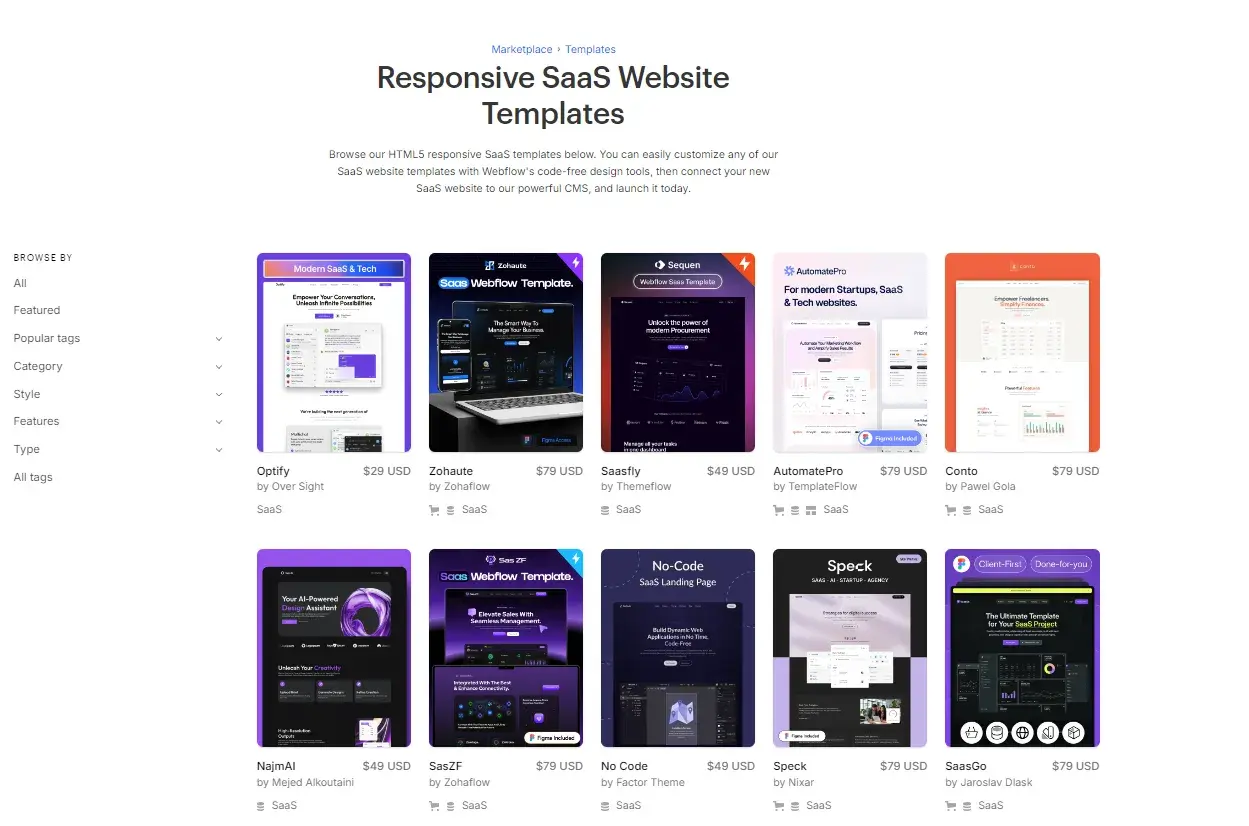
Webflow is a great CMS for SaaS businesses, and it is worthy of consideration for businesses of all sizes.
There are two things that stand out to me. First, like WordPress, Webflow allows you to use WYSIWYG editors or drag-and-drop builders so you can create a site without a developer, but if you want something custom, you can add code, too.
Second, the Figma sync is really cool. You can turn designs into pages with the plugin.
Webflow also includes hosting and CMS capabilities, so if you wanted one platform to do it all, Webflow could be the one for you.
Stan Rymkiewicz, Head Of Growth at Default, relies on Webflow and makes the most of its CMS, too!
Rymkiewicz says, “Webflow empowers Default to move fast. Its no-code tools let us make real-time updates without developer bottlenecks, while the flexible CMS helps us scale content like product pages and blogs. With built-in SEO and third-party integrations, it's perfect for a SaaS like ours focused on agility and growth.”
Features
- Drag-and-drop editor so you can create your website without the need for developers. Though, it’s worth noting you can also add custom code so you can customize your site as you like if you’ve got a developer.
- You can sync Webflow to Figma with a plugin. This allows you to copy and paste designs into Webflow.
Pricing: You can start with Webflow for free, but you are limited to two pages. The smallest package is $14/month and rises to $39/month depending on what functionality you need.
Best for: Webflow is worth considering for most businesses. Startups and small businesses looking for a complete web design and hosting solution can use it with or without developer support. But it’s also suitable for larger businesses.
Ready to try a new SaaS CMS?
In this article, I discovered five of the best content management systems for SaaS. After talking to people working in SaaS and using the CMS daily, I found that developers want flexibility, and content creators want ease of use. Integrations into other systems and functionality to track metrics were desirable.
Consider what you and your team need before taking the leap and trying a new SaaS CMS. No doubt, there will be a perfect solution for you.
Content Management System








![20 Best Membership Website Builders and Platforms [+My Favorite Examples]](https://53.fs1.hubspotusercontent-na1.net/hubfs/53/14%20Best%20Membership%20Website%20Builders%20and%20Platforms%20in%202022%20%5B+%20Website%20Examples%5D.png)



